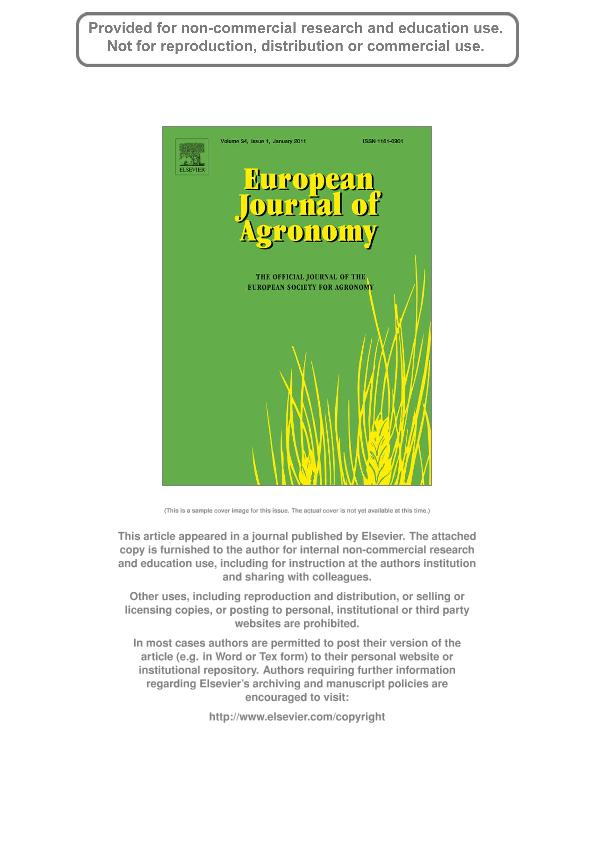Mostrar el registro sencillo del ítem
dc.contributor.author
Rondanini, Deborah Paola

dc.contributor.author
Gomez, Nora Valentina

dc.contributor.author
Agostini, María Belén

dc.contributor.author
Miralles, Daniel Julio

dc.date.available
2018-09-24T14:10:47Z
dc.date.issued
2012-02
dc.identifier.citation
Rondanini, Deborah Paola; Gomez, Nora Valentina; Agostini, María Belén; Miralles, Daniel Julio; Global trends of rapeseed grain yield stability and rapeseed-to-wheat yield ratio in the last four decades; Elsevier Science; European Journal of Agronomy; 37; 1; 2-2012; 56-65
dc.identifier.issn
1161-0301
dc.identifier.uri
http://hdl.handle.net/11336/60711
dc.description.abstract
Increases in crop yields are important to ensure food supply for humanity. Global yield trends have been analyzed considering public national average data, mainly for cereals but not for rapeseed. As rapeseed and wheat compete for land in crop rotation, it is also important to know how the rapeseed-to-wheat yield ratio is modified in different environments so as to make rapeseed an attractive alternative for farmers around the world. The present study analyzed historical records of rapeseed from FAO determining yield stability trends over the last 40yr, as well as rapeseed competitiveness compared to wheat. Twelve countries representing a wide range of environments and farming systems were taken into account. Regressions were fitted to the rapeseed yield/time relationships and residuals of these regressions were used to evaluate trends in yield stability. Results showed a global rapeseed yield gain of 27kgha -1yr -1 along the past 40yr, although fluctuating among decades. In relative terms to 1970, world rapeseed yield increased 3.4%yr -1. Yield gain in different countries varied from 15 to 40kgha -1yr -1, exhibiting linear, bi- or tri-linear yield trends. Opposite yield trends were observed for Chile and the UK, with sustained yield gain for the former and leveling off for the latter since the mid 1980s. This does not seem to be related to the supply of environmental resources (both countries yielding >3000kgha -1). A high variability was detected in national yields (0-750kgha -1 or 0-60% of yield) and yield stability did not increase over the last 40yr in any country. Rapeseed and wheat yields, expressed in relative terms to their values for 1970, increased in a similar proportion over the last four decades. Global rapeseed-to-wheat ratio ranged 40-60% over the last 40yr, but rapeseed yields can increase up to 80-100% with respect to wheat in poor environments for wheat (<2000kgha -1), leveling off around 40% in high wheat yields environments (>4000kgha -1). It was concluded that rapeseed yields have increased steadily in the last 40yr in most studied countries, the yield gain was not accompanied by greater yield stability, and rapeseed competitiveness compared to wheat is at least 40-50% in environments with good supply of resources. © 2011 Elsevier B.V.
dc.format
application/pdf
dc.language.iso
eng
dc.publisher
Elsevier Science

dc.rights
info:eu-repo/semantics/openAccess
dc.rights.uri
https://creativecommons.org/licenses/by-nc-sa/2.5/ar/
dc.subject
National Trends
dc.subject
Rapeseed
dc.subject
Rapeseed-To-Wheat Ratio
dc.subject
Yield
dc.subject
Yield Stability
dc.subject.classification
Agricultura

dc.subject.classification
Agricultura, Silvicultura y Pesca

dc.subject.classification
CIENCIAS AGRÍCOLAS

dc.title
Global trends of rapeseed grain yield stability and rapeseed-to-wheat yield ratio in the last four decades
dc.type
info:eu-repo/semantics/article
dc.type
info:ar-repo/semantics/artículo
dc.type
info:eu-repo/semantics/publishedVersion
dc.date.updated
2018-09-10T16:31:21Z
dc.journal.volume
37
dc.journal.number
1
dc.journal.pagination
56-65
dc.journal.pais
Países Bajos

dc.journal.ciudad
Amsterdam
dc.description.fil
Fil: Rondanini, Deborah Paola. Consejo Nacional de Investigaciones Científicas y Técnicas; Argentina. Universidad de Buenos Aires. Facultad de Agronomía. Departamento de Producción Vegetal. Cátedra de Cerealicultura; Argentina
dc.description.fil
Fil: Gomez, Nora Valentina. Universidad de Buenos Aires. Facultad de Agronomía. Departamento de Producción Vegetal. Cátedra de Cultivos Industriales; Argentina
dc.description.fil
Fil: Agostini, María Belén. Consejo Nacional de Investigaciones Científicas y Técnicas; Argentina. Universidad de Buenos Aires. Facultad de Agronomía. Departamento de Producción Vegetal. Cátedra de Cultivos Industriales; Argentina
dc.description.fil
Fil: Miralles, Daniel Julio. Consejo Nacional de Investigaciones Científicas y Técnicas. Oficina de Coordinación Administrativa Parque Centenario. Instituto de Investigaciones Fisiológicas y Ecológicas Vinculadas a la Agricultura. Universidad de Buenos Aires. Facultad de Agronomía; Argentina. Universidad de Buenos Aires. Facultad de Agronomía. Departamento de Producción Vegetal. Cátedra de Cerealicultura; Argentina
dc.journal.title
European Journal of Agronomy

dc.relation.alternativeid
info:eu-repo/semantics/altIdentifier/doi/https://dx.doi.org/10.1016/j.eja.2011.10.005
dc.relation.alternativeid
info:eu-repo/semantics/altIdentifier/url/https://www.sciencedirect.com/science/article/pii/S1161030111001213
Archivos asociados
